In vitro axenic germination and cultivation of mixotrophic Pyroloideae (Ericaceae) and their post-germination ontogenetic development
- PMID: 30403767
- PMCID: PMC6417480
- DOI: 10.1093/aob/mcy195
In vitro axenic germination and cultivation of mixotrophic Pyroloideae (Ericaceae) and their post-germination ontogenetic development
Abstract
Background and aims: Pyroloids, forest sub-shrubs of the Ericaceae family, are an important model for their mixotrophic nutrition, which mixes carbon from photosynthesis and from their mycorrhizal fungi. They have medical uses but are difficult to cultivate ex situ; in particular, their dust seeds contain undifferentiated, few-celled embryos, whose germination is normally fully supported by fungal partners. Their germination and early ontogenesis thus remain elusive.
Methods: An optimized in vitro cultivation system of five representatives from the subfamily Pyroloideae was developed to study the strength of seed dormancy and the effect of different media and conditions (including light, gibberellins and soluble saccharides) on germination. The obtained plants were analysed for morphological, anatomical and histochemical development.
Key results: Thanks to this novel cultivation method, which breaks dormancy and achieved up to 100 % germination, leafy shoots were obtained in vitro for representatives of all pyroloid genera (Moneses, Orthilia, Pyrola and Chimaphila). In all cases, the first post-germination stage is an undifferentiated structure, from which a root meristem later emerges, well before formation of an adventive shoot.
Conclusions: This cultivation method can be used for further research or for ex situ conservation of pyroloid species. After strong seed dormancy is broken, the tiny globular embryo of pyroloids germinates into an intermediary zone, which is functionally convergent with the protocorm of other plants with dust seeds such as orchids. Like the orchid protocorm, this intermediary zone produces a single meristem: however, unlike orchids, which produce a shoot meristem, pyroloids first generate a root meristem.
Keywords: Chimaphila; Moneses; Monotropa; Pyrola; in vitro culture; Ericaceae; convergent evolution; mixotrophy; orchid; protocorm; seed dormancy; seed germination.
© The Author(s) 2018. Published by Oxford University Press on behalf of the Annals of Botany Company. All rights reserved. For permissions, please e-mail: journals.permissions@oup.com.
Figures
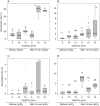

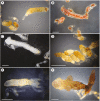
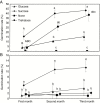
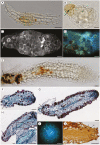
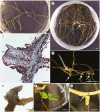

Similar articles
-
Mixotrophy in Pyroleae (Ericaceae) from Estonian boreal forests does not vary with light or tissue age.Ann Bot. 2017 Sep 1;120(3):361-371. doi: 10.1093/aob/mcx054. Ann Bot. 2017. PMID: 28575199 Free PMC article.
-
Parallel evolutionary paths to mycoheterotrophy in understorey Ericaceae and Orchidaceae: ecological evidence for mixotrophy in Pyroleae.Oecologia. 2007 Mar;151(2):206-17. doi: 10.1007/s00442-006-0581-2. Epub 2006 Nov 7. Oecologia. 2007. PMID: 17089139
-
Fungal host specificity is not a bottleneck for the germination of Pyroleae species (Ericaceae) in a Bavarian forest.Mol Ecol. 2013 Mar;22(5):1473-81. doi: 10.1111/mec.12180. Epub 2013 Jan 24. Mol Ecol. 2013. PMID: 23347020
-
A perspective on orchid seed and protocorm development.Bot Stud. 2017 Dec;58(1):33. doi: 10.1186/s40529-017-0188-4. Epub 2017 Aug 4. Bot Stud. 2017. PMID: 28779349 Free PMC article. Review.
-
Orchid Reintroduction Based on Seed Germination-Promoting Mycorrhizal Fungi Derived From Protocorms or Seedlings.Front Plant Sci. 2021 Jun 30;12:701152. doi: 10.3389/fpls.2021.701152. eCollection 2021. Front Plant Sci. 2021. PMID: 34276753 Free PMC article. Review.
Cited by
-
Japonolirion osense, a close relative of the mycoheterotrophic genus Petrosavia, exhibits complete autotrophic capabilities.BMC Plant Biol. 2024 Nov 8;24(1):1058. doi: 10.1186/s12870-024-05721-1. BMC Plant Biol. 2024. PMID: 39516734 Free PMC article.
-
Chimaphila umbellata; a biotechnological perspective on the coming-of-age prince's pine.Phytochem Rev. 2023 Jun 8:1-16. doi: 10.1007/s11101-023-09880-1. Online ahead of print. Phytochem Rev. 2023. PMID: 37359710 Free PMC article. Review.
-
Root-Associated Fungal Communities in Two Populations of the Fully Mycoheterotrophic Plant Arachnitis uniflora Phil. (Corsiaceae) in Southern Chile.Microorganisms. 2019 Nov 20;7(12):586. doi: 10.3390/microorganisms7120586. Microorganisms. 2019. PMID: 31756978 Free PMC article.
-
Mycoheterotrophy in the wood-wide web.Nat Plants. 2024 May;10(5):710-718. doi: 10.1038/s41477-024-01677-0. Epub 2024 Apr 19. Nat Plants. 2024. PMID: 38641664 Review.
References
-
- Arditti J. 1967. Factors affecting the germination of orchid seeds. Botanical Review 33: 1–97.
-
- Arditti J. 2008. Micropropagation of orchids, Vol. 1, 2nd edn. Chichester, UK: John Wiley and Sons.
-
- Arditti J, Ghani A. 2000. Numerical and physical properties of orchid seeds and their biological implications. New Phytologist 145: 367–421. - PubMed
-
- Bartlett M. 1937. Properties of sufficiency and statistical tests. Proceedings of the Royal Society A: Mathematical and Physical Sciences 160: 268–282.
-
- Bernard N. 1909. L’évolution dans la symbiose. Les Orchideés et leurs champignons commensaux. Annales des Sciences Naturelles Serie (Botanique) 9: 1–196.

